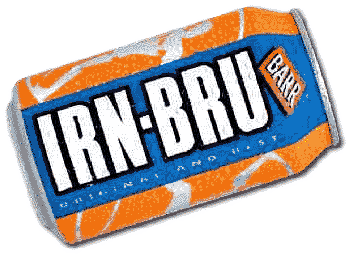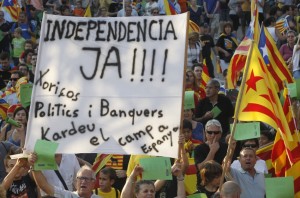 With the upcoming vote on independence, there have been a good number of stories in the US media about Scotland. Of particular interest seem to be stories about the distinctiveness of Scottish life and culture (especially as differentiated from England). On NPR this week there was a story about Irn-Bru, an orange flavored soft drink very popular in Scotland. The story featured interviews with Scots professing their love the neon orange colored drink, connecting that passion with Scottish patriotism:
With the upcoming vote on independence, there have been a good number of stories in the US media about Scotland. Of particular interest seem to be stories about the distinctiveness of Scottish life and culture (especially as differentiated from England). On NPR this week there was a story about Irn-Bru, an orange flavored soft drink very popular in Scotland. The story featured interviews with Scots professing their love the neon orange colored drink, connecting that passion with Scottish patriotism:
As Scots prepare to vote on independence next month, the fizzy fervor for this fluorescent fluid may offer some insights into Scottish nationalistic tendencies. When asked why they’re so crazy for this Scottish soda, people most often reply, “Because it’s Scottish.”… Much of the world treats Scottish icons as kitsch. Kilts. Haggis. Bagpipes. But for Scots, these are potent symbols of national pride. One of Irn Bru’s advertising slogans is “Made in Scotland, from girders.” Girders, as in the steel beams that hold up buildings.
I have to admit that although I have visited Scotland several times, I have never tasted Irn-Bru, although I did liberally partake of Scottish ale, which has its fans as well, although it certainly pales in popularity to Scotland’s true national drink, Scotch whisky.
The NPR story led me to think about other soft drinks associated with specific cultures. The obvious example is Coca-Cola, a US icon, but less well known are some other drinks I have sampled. In Austria, for example, students I have taken on study abroad trips often discover and enjoy Almdudler, a carbonated drink made from apple, grape, and herb flavors. In Germany Spezi is popular – cola mixed with orange soda, as is Apfelshorle, apple juice mixed with minteral water. On hot summer days in Bavaria, I have enjoyed drinking a Radler or two, a mix of beer with lemon soda.
Particularly memorable for me was drinking cold Kvass in Moscow a few summers ago, when there were massive fires in the region, covering the capital in smoke, with the temperature the hottest it had been in years. Kvass is a slightly alcoholic drink (at most 1.5%) made from fermenting black or rye bread and one of the few drinks in Russia consistently served ice cold. In the summer there are Kvass stands all around, similar to root beer stands in the US at state fairs.
A drink I have heard about but never tasted is Inca Kola, a widely enjoyed soft drink in Peru. I would guess, given its popularity, that the Peruvian cola must be much better than the worst cola I have ever had, which was in East Berlin before German reunification. Coca-Cola, as a symbol of capitalism, was not available in the German Democratic Republic, instead a home-brewed version was made, Vita-Cola. To me it tasted like soap, but maybe it was just a bad batch, because with the nostalgia for things East German (“Ostalgie”), Vita-Cola has enjoyed a comeback.

